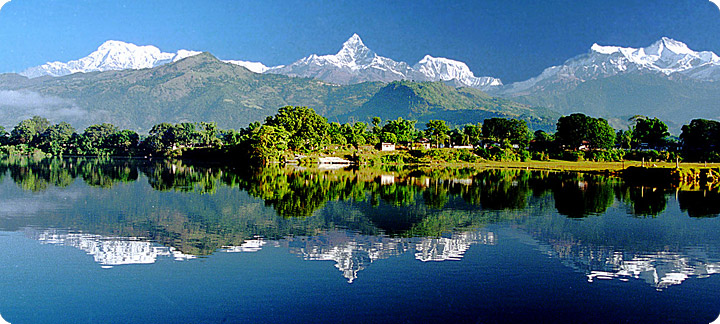
Neolithic tools found in the Kathmandu Valley indicate that people have been living in the Himalayan region for at least 9,000 years. It appears that people who were probably of Tibeto-Burman ethnicity lived in Nepal 2,500 years ago.
Nepal is a landlocked nation in South Asia, bordering the People's Republic of China to the north and India to the south, east and west. Nepal previously had the distinction of being the world's only Hindu state, with over eighty percent of the people following this faith. However, on 18 May 2006, Nepal was declared a secular state.
For a relatively small country, the Nepali landscape is uncommonly diverse, ranging from the humid Terrai in the south to the lofty Himalayas in the north. Nepal boasts eight of the world's ten highest mountains, including Mount Everest on the border with China. Kathmandu is the capital and largest city. The exact origin of the name Nepal is uncertain, but the most popular understanding is that it is derived from Ne (holy) and pal (cave).
If the country was divided by its 3 geographical regions you would experience the world's deepest gorge called Kali-Gandaki and the highest point on earth, Mt. Everest, diversity that cannot be matched anywhere else in the world.
The valleys in Nepal are overlooked by snow-capped peaks, whilst at the other extreme the Terai jungle region offers a variety of birdlife and animals including the almost extinct single-horned Asiatic rhino. Situated at the foot of the Himalayas is Chitwan which is one of the few undisturbed areas of the Terai jungle and is also one of the last places where you will find the Bengal tiger. If you are interested you can take an elephant ride to see the rhinos.
The amazing mountain views are breathtaking and you can choose from the popular sacred (Fishtail) mountain in Pokhara to the stunning heights of Mount Everest. These stunning Mountains have crystal clear streams, a varied and colourful variety of flowers and birds.
One of the best ways to experience the natural beauty and cultural riches of Nepal is to walk through them. New sights, sounds and smells are a magnificent treat for the senses in an experience of a lifetime, where you will traverse the beaten trails. Never will you experience as many rhododendrons (April and May is a good time) as you will find in the beautiful forests of Nepal.
Kathmandu is an experience in itself and stands out in total contrast to its beautiful natural surroundings. This however does not make it less of an experience. There are some awesome carved temples of ancient times that are interspersed with modern towers. Part of the atmosphere of Kathmandu is the throng of beggars hoping to make a few pence from the many tourists and the monkeys who are equally looking for a way to survive. All of this and the choking diesel fumes have become what modern day Kathmandu is all about. If you are wondering about the best time to visit then I would advise the months of October and November as it is the beginning of the dry season.
If trekking is not enough of an experience for you then you could try whitewater rafting in the beautiful surroundings or maybe experiencing the wildlife in its natural habitat.
You cannot go to Nepal and not experience one of their Festivals, which although very spectacular, are a living part of the cultural heritage. Festivals bring together the Nepalese people whatever their backgrounds and beliefs into one nation.
Technological backwardness and the long-running civil war have also prevented Nepal from fully developing its economy. The country receives foreign aid from several countries including India.